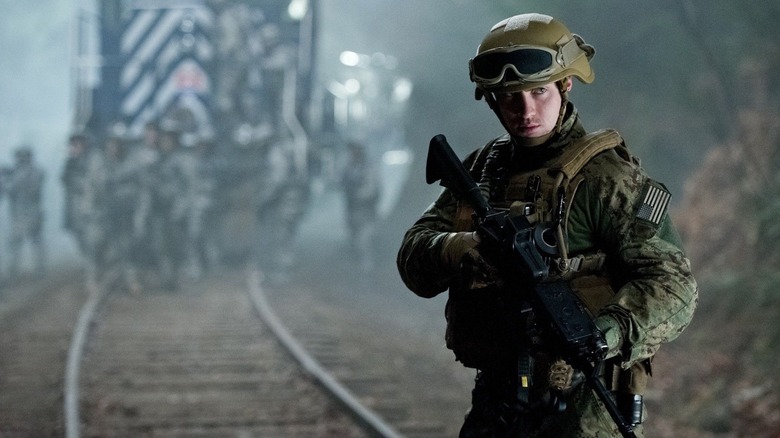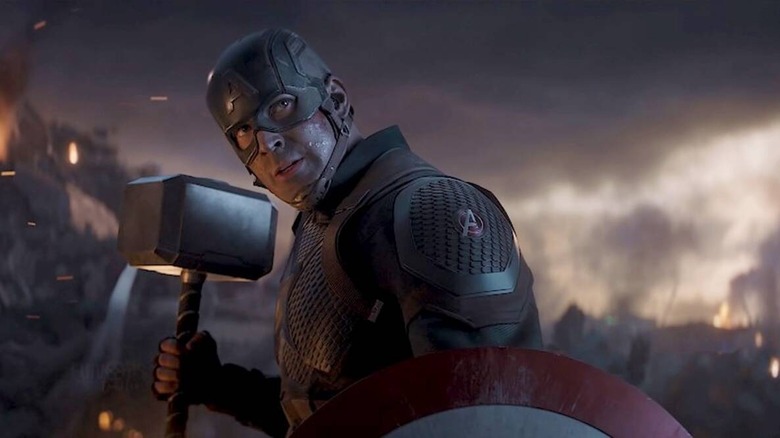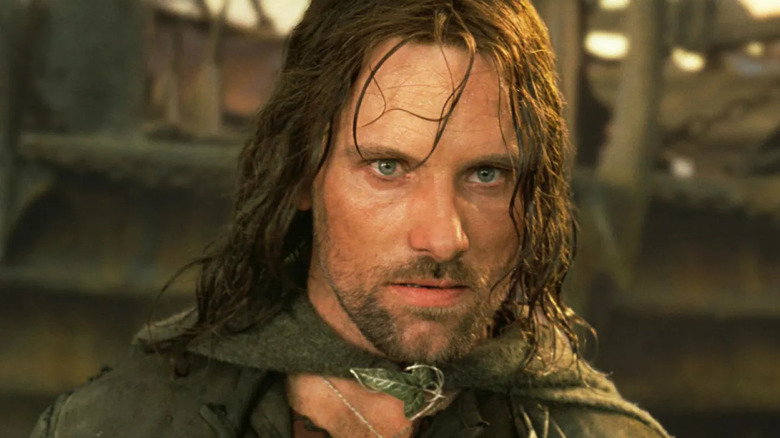Characters With The Thickest Plot Armor In Movie History
It's always preferable for movies to make sense and for the hero to only overcome the obstacles before them and beat the villain by applying the lessons they'd learned at least somewhat within the bounds of reason. But sometimes scripts are due on Thursday, okay?
Jokes aside, plot armor — when important characters illogically survive fatal danger simply because the story requires them to get to the finish line — is indicative of some seriously lazy writing. And sadly, it's far from uncommon. Chances are, even some of your favorite movies have indulged in this cheap, eye-roll-inducing tactic, even if you didn't notice it at first.
Whether it's a character emerging unscathed from a disaster that killed everyone around them, taking enough punishment to cripple Superman and somehow limping away with scrapes and bruises, or only facing off against enemies with terrible aim, plot armor has become so baked into the cake of Hollywood that it often goes unnoticed. But not by us. From Aragorn to James Bond to just about everyone in the "Pirates of the Caribbean" movies, we've assembled a list of movie characters with the beefiest plot armor.
Ford Brody from Godzilla
In 2014's "Godzilla," the titular and legendary lizard monster is only one of several kaiju that start stomping across an unprepared world. Our main hero is Ford Brody (Aaron Taylor-Johnson) because he just so happens to always be right where the action is.
Seriously, the sheer number of monster attacks Brody finds himself in the middle of throughout the movie is laughable. Sure, he's in the military and very much part of the response to these threats, and he also has a personal score to settle with MUTOs (Massive Unidentified Terrestrial Organisms) after one killed his father. So he's not some random dude. However, he's also not being deliberately put where Godzilla or the other MUTOs will attack next because nobody knows where that will be. And no, the monsters are not going out of their way to target him or his comrades either. When there are this many coincidences, it becomes impossible to get properly immersed in the story.
Perhaps even more unrealistic is the fact that Brody is often the only survivor of the rampages and never suffers more than scrapes and bruises even when everyone and everything around him is killed and destroyed. It wouldn't have been hard to write a version of this story where the military did know where Godzilla was going, and/or numerous characters survive the encounters. We'd still get plenty of epic monster action without our suspension of disbelief being broken. However, his survival rate requires some serious suspension of disbelief.
Multiple characters in King Kong
In Peter Jackson's 2005 epic, star-studded adventure drama "King Kong," an ambitious filmmaker named Jack Driscoll decides to film on Skull Island, which houses cannibalistic tribes, dinosaurs, and a particular gigantic ape that they kidnap and take back to New York City as a tourist attraction (which doesn't go well).
In one scene on the island, the film crew winds up in the path of panicked, stampeding brontosauruses who are fleeing a pack of hungry velociraptors. It's impossible to just get off the path due to the narrow terrain, so they have no choice but to run for their lives alongside the charging dinosaurs. It makes for some pretty impressive cinematic spectacle, but it's tough to get immersed in the moment because you're distracted by the fact that no human being could survive this for more than five seconds.
Seriously, it's more than a little bit ridiculous. Brontosauruses are some of the largest animals that have ever existed, for one. This many of them, barreling forward in a panic, would've squashed any unlucky humans in their way like so many grape tomatoes. Add to that a pack of rabid, snapping raptors who'd munch on just about anything, plus the fact that humans are quite a bit slower than both species, and we're talking about one of the silliest examples of plot armor ever. You'd have more luck trying to dodge bullets than this inescapable freight train of cold blooded flesh and razor sharp teeth.
Harry Potter
Despite being one of the most famous wizards in J.K. Rowling's universe, Harry Potter himself isn't particularly talented with magic. What he is, though, is nearly indestructible. The whole story begins when he survives Voldemort's Avada Kedavra killing curse with little more than a cool forehead scar to show for it, thanks to a protective spell sacrificially placed on him by his mom. In the final movie, it's revealed that this incident makes Harry the final Horcrux (an object containing a piece of Voldemort's soul that will ensure the dark lord's resurrection unless destroyed). Realizing he must die before Voldemort can, he allows himself to be killed. But somehow, He Who Must Not Be Named manages only to kill the piece of himself buried inside Harry. In his imagination, Dumbledore tells Harry he can survive by merely choosing to live. An hour or so later, Harry is running around as if nothing happened. How convenient.
In other instances throughout the series, Harry just appears to be very lucky. For example, both Barty Crouch, Jr. and Peter Pettigrew let numerous opportunities to kill Harry slip past them. Voldemort himself seems to take his time going after Harry, too. And on several occasions, Harry falls off his broomstick during Quidditch matches, is beaten and stabbed, and even bitten by poisonous creatures. In every circumstance, friendly wizards are conveniently nearby to save or heal him. So while there might be plot explanations for these events, they're all quite convenient — you might even say magic.
Captain America
It's one thing for characters like Thor and the Hulk — or even Iron Man in his high-tech suit — to take more punishment than your average Joe. But Steve Rogers aka Captain America doesn't have superpowers. The serum he was injected with in "The First Avenger" beefed him up to peak physical condition, but he wasn't exactly shooting laser beams from his fingers. And yet, he's proven himself more than once to be just as strong, fast, and resilient as literal gods.
He's constantly limping away from huge falls and explosions with nothing but scrapes and bruises. He's been punched, choked, and kicked thousands of times, often by people who could throw cars. In "The Winter Soldier," he's even shot repeatedly. It clearly hurts, but it doesn't kill him.
In "Avengers: Endgame," everyone enjoys plot armor when they all inexplicably survive Thanos blowing up their headquarters with his starship. But still, Cap stands out during his one-on-one fight with the Mad Titan. Thanos is a weird character who, rather than having a consistent strength level, always seems to be 10 to 30% stronger than whoever he's fighting. Still, he throws Captain America around like a rag doll and even breaks his supposedly indestructible vibranium shield. And yet, Cap himself is merely winded when the fight is over, and they're both forced to deal with the other guy's army. Is Steve somehow more resilient than his shield? If so, why does he need it at all? Just to throw it?
Gerry from World War Z
Very loosely based on the novel of the same name, "World War Z" puts Brad Pitt's Gerry Lane in the midst of a zombie apocalypse that turns the world upside-down. And these aren't slow zombies either. They're the fast, rabid kind, and they travel in hordes of thousands at a time, like an ocean tide in the middle of a storm. In the most memorable scene, the Israelis have built a wall to keep them out, but the zombies just climb on top of each other until there's a ramp of rotting flesh so high they're not only pouring over the edge but nearly catching fleeing helicopters. They're hard to escape, in other words.
Gerry never has much trouble getting away from them, though, even when soldiers with machine guns and Kevlar go down in less than a minute. The movie never puts him in a position where he's not the closest person to a convenient escape hatch that nobody else has noticed. And despite being a scientist, Gerry doesn't have that much common sense. In the climax of the movie, he's rummaging around a zombie-infested lab without the codes he needs to access the right parts. He does have a gun, but he mindlessly puts it down and forgets about it the second the plot needs there to be tension. Yet, still, he gets away scot-free, even after getting trapped by zombies in a small room without a weapon.
John Rambo
As is the case with several movies on this list, it almost feels like cheating to mention the plot armor in the "Rambo" movies when plot armor is the character's defining feature. But it'd feel even weirder not to mention it, so here we are.
The first "Rambo" movie is actually deeper and more subtle than the series' overall reputation would suggest. If you haven't seen it, John, a traumatized Vietnam vet just trying to scrape by after returning home, is constantly harassed and attacked by the sadistic authorities of Hope, Washington. There's plenty of improbable, one-man army content here, but a lot of it relies on Rambo's proficiency in guerilla warfare, rather than his ability to casually stroll through a wall of gunfire without so much as a Kevlar vest. Plus, we get disarmingly thought-provoking commentary on the experience of veterans and PTSD.
Rather, it's in the sequels where the series loses all grasp of nuance and is catapulted to the highest levels of majestic '80s schlock. Rambo, usually shirtless, mows down wave after wave of faceless baddies with such poor aim they make Imperial stormtroopers look like Barry Pepper from "Saving Private Ryan." Even in the age of the musclebound B-movie action hero, Rambo's demigod-like exploits are so silly they spawned multiple comedic spoofs, like Weird Al's movie "UHF" and "Hot Shots: Part Deux." As funny as those are, though, it wasn't necessary — "Rambo" ultimately became a spoof of itself, and that's why we love it.
Katniss Everdeen
Some plot armor is baked into the cake for Katniss Everdeen, whose well-honed but hardly Legolas-level archery skills somehow carry her to victory through two Hunger Games and violent civil war. That's fine on paper, we suppose, but the movies make no attempt to ground any of it in realism.
During the titular tournaments themselves, Katniss is frequently alone or weighed down by people either too young or wounded to carry their weight, often while being hunted by entire teams of lethal killers who've been training for the Games their entire lives. Yet she never fails to come out on top. Whenever she's in trouble, food and medicine literally fall out of the sky to get her through, or would-be killers just decide not to finish her off. When the game makers throw killer "muttations" and fireballs at the combatants, only Katniss and Peeta survive. You don't say!
After the Games, when she can no longer rely on airdrops, she somehow still manages to survive a nearly fatal attack by brainwashed Peeta, an explosion that kills her sister, and no shortage of field combat. Also, she's constantly, and publicly, defying dictators without facing any serious consequences. The first incident works because she exploits the fact that the Games must have a winner. Afterward, her celebrity status makes her hard to kill. That's fine. But assassinating newly empowered President Coin in full view of the entire realm and getting away with it? That's quite hard to believe.
Everyone in Pirates of the Caribbean
The "Pirates of the Caribbean" movies started out on a wild note and only escalated from there. That's part of the charm, of course, but the sheer amount of lucky coincidences multiple characters depend on to survive does leave us scratching our heads. At the end of the second movie, it's revealed that Captain Barbossa survived being shot in the heart at the end of the first one because ... reasons. Then, at the beginning of the third film, we see that Jack Sparrow, who got eaten by the Kraken in "Dead Man's Chest," is alive and well because, well, the charming swashbuckler simply must survive. It's the rule.
Throughout the rest of the series, both main and supporting characters survive — unscathed, mind you — outrageously dangerous circumstances. In "The Curse of the Black Pearl," Jack somehow evades a full brigade of redcoats. Later on, the heroes survive a ship-to-ship scrape with Barbossa's unkillable pirates despite being so short on ammo they're forced to shoot forks from the 12-pounders. In "Dead Man's Chest," the same lucky pirates are trapped in a bone cage and rag-dolled around an island canyon, yet barely dizzy when it's over. And in "At World's End," Will and Elizabeth infamously get married in the middle of a pirate death match. We could go on and on about the other countless times characters made it through shootouts, shipwrecks, would-be executions, sword fights, ancient curses, hard falls, and encounters with 50-foot sea creatures, without sustaining serious injuries, but you get the idea.
Black Widow
It's silly enough for Captain America to endure weekly cosmic beatdowns without so much as a black eye, but at least he had a super soldier serum and an indestructible shield. What does Natasha Romanoff aka Black Widow have? Enough spy slash martial arts skills to take down a room full of red shirt goons, sure. But it was always weird to see her standing next to characters who could win fist fights against planet-killing gods. Still, as long as she had Thor and Scarlet Witch backing her up, her survival was just believable enough to work.
But 2021's "Black Widow" is where things start to get more than a little bit silly. In this story, Natasha reunites with her family and seeks revenge against Dreykov, the sadistic General who kidnaps young girls and turns them into lethal, brainwashed superspies.
Throughout the movie, Natasha — a well-trained and physically fit fighter but hardly a superhero — sustains so much damage it shatters your suspension of disbelief. She survives two brutal, fiery car crashes, a fall from the top of an apartment complex in which she smashes her face and ribs into every pipe on the way down, numerous massive explosions, brutal fistfights, the violent destruction of Dreykov's sky fortress that she's trapped inside, and the miles-long resulting fall in which she and Taskmaster smash each other through debris and their one parachute fails to deploy properly. At no point does she ever do more than wince in pain.
Aragorn
Many "Lord of the Rings" characters have enjoyed plot armor. Gandalf was resurrected, for example, and Frodo nearly made this list due to the Nazgul's bewildering inability to simply reach out and grab the One Ring on multiple occasions. At Weathertop in the first movie, the Witch King saw the Ring — the one thing he was tasked with recovering – and chose to stab Frodo with a magical knife instead. During the Battle of Osgiliath in the second movie, Frodo literally holds the Ring out to a Ringwraith on a fell beast — which then flies away after getting shot with one arrow. Given the events of the third movie, it's clear that the particular wraith didn't even report what he saw to Sauron.
But nobody has thicker plot protection than Aragorn, who gets himself surrounded by orcs at least once per movie, only for them to inexplicably attack him one at a time, and even survives falling off an enormous cliff in "The Two Towers." He was wounded and unconscious for a bit, so it's unlikely he only hit the water on his way down. And yet, mere hours later, he's leading the defense of Helm's Deep. During that battle, Aragorn is the only survivor of a massive mine that blows up the wall beneath his feet, sending him flying. In the third movie, a giant troll literally steps on him. 10% more weight on that foot would've ended the guy, but then the troll gets spooked and runs off.
James Bond
James Bond shouldn't have survived the opening scene of his first movie. First of all, the average Bond villain is ludicrously well-funded, surrounded by a private army, and hidden away in a fortress with some kind of doomsday weapon. Second, 007 is never tasked with merely collecting information on these baddies like an actual spy. Instead, he's almost always charged with taking down their entire dastardly organization by himself. So calling him a "spy" is like the president of the United States putting "managerial experience" on a resume. Thirdly, Bond is rarely equipped with the proper tools to wage a one-man war against a small army. As cool as a pen that shoots poison darts may well be, we think body armor, a radio for air strikes, a few dozen comrades, and something that packs a bit more of a punch than a puny sidearm would be a far more appropriate loadout for jobs like these. Lastly, real spies are careful with their aliases and like to fly under the radar. Bond, meanwhile, happily blurts out his actual name to anyone who asks.
And yet, "Bond, James Bond" is rarely more than moderately injured in his movies (with the exception, of course, of Daniel Craig's final run in the films). It helps that the goons he fights can't aim and that the big bad would always rather monologue before leaving the room while he's slowly lowered into a shark pit. Just shoot the guy, Blofield. How hard would that be?











